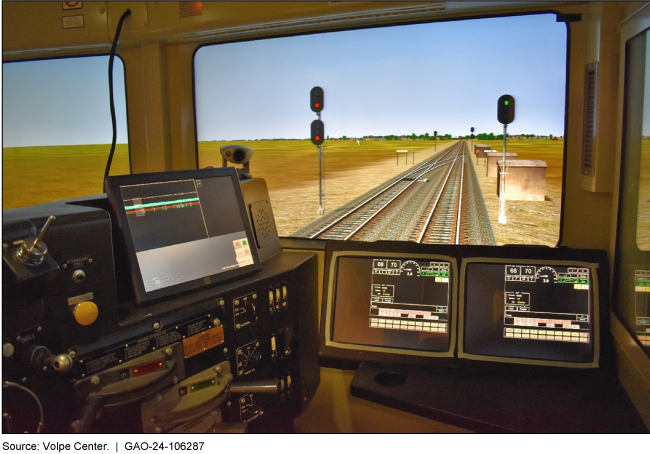Surface Transportation: DOT Considers Multiple Factors when Choosing the Volpe Center to Conduct Research
Fast Facts
The Department of Transportation funds research aimed at making the nation's transportation system safer and more efficient. DOT agencies, nonfederal entities, and the Volpe Center—DOT's fee-for-service innovation center—conduct research.
Five DOT agencies committed a total of $50.5 million—13% of their total fiscal year 2022 research funding—to the Volpe Center. The remaining 87% went to universities, businesses, and other entities.
DOT officials said they choose to work with Volpe due to the expertise of its staff, the nature of the work, and the response time. For example, DOT has relied on Volpe for air quality and noise research since 1970.
This highway-rail grade safety simulator is an example of how the Volpe Center supports the Federal Railroad Administration with research.

Highlights
What GAO Found
The U.S. Department of Transportation's (DOT) operating administrations enter into agreements with DOT's John A. Volpe National Transportation Systems Center (Volpe Center) for a variety of services, including research. DOT officials told GAO that they consider multiple factors when choosing the Volpe Center to conduct research or perform other services. These factors include:
- Expertise. DOT officials told GAO that they consider the Volpe Center's expertise and institutional knowledge on a topic. For example, the Federal Highway Administration has leveraged the Volpe Center's technical expertise in noise reduction and air quality to create tools for state and regional officials to demonstrate reduced congestion and improved air quality.
- Nature of the work. DOT officials told GAO that, because the Volpe Center is a part of the agency, certain issues (e.g., inherently governmental functions) are best addressed by Volpe Center staff. For example, Volpe Center staff have long served as the primary technical resource informing the National Highway Traffic Safety Administration's fuel economy standards rulemaking.
- Response time. DOT officials told GAO that the Volpe Center's ability to rapidly respond to agency needs is also a consideration. Volpe Center officials cited the center's recent work to help form the new Joint Office of Energy and Transportation, which involved performing technical reviews of grant applications, as an example of its ability to respond rapidly.
The proportion of research funding committed to the Volpe Center compared to other entities varied across five selected DOT operating administrations in fiscal year 2022 (see figure). Combined, these operating administrations committed a total of $50.5 million—13 percent of their total fiscal year 2022 research funding—to the Volpe Center. The remaining 87 percent went to other entities such as universities, businesses, and non-profit organizations.
Research Funding Committed to the Volpe Center and Other Entities by Five Department of Transportation Operating Administrations, Fiscal Year 2022

DOT operating administrations manage their respective research portfolios. According to DOT officials, each operating administration's distribution of research funding is driven by its mission and role, the scope of individual projects, and the factors described above.
Why GAO Did This Study
DOT's research activities are critical to its mission of making the nation's transportation system safer and more efficient. In 2020, GAO found that this research may be conducted by the agency's operating administrations, nonfederal research entities, or DOT's Volpe Center. DOT established what is now the Volpe Center in 1970. Its mission is to improve the U.S. transportation system by anticipating emerging issues and advancing technical, operational, and institutional innovations for the public good.
The Infrastructure Investment and Jobs Act includes a provision for GAO to review the surface transportation activities at the Volpe Center. This report describes (1) factors that selected DOT operating administrations consider when choosing the Volpe Center for research or other services, and (2) how much research funding selected DOT operating administrations committed to the Volpe Center compared to other entities in fiscal year 2022, among other objectives.
GAO selected five DOT operating administrations for analysis that have a surface transportation-focused mission, are responsible for duties and initiatives intended to improve the safety of the traveling public, and entered into agreements with the Volpe Center in fiscal year 2022. GAO also reviewed relevant laws and DOT policies; analyzed DOT data; and interviewed officials from DOT, the Volpe Center, and the five selected operating administrations.
For more information, contact Elizabeth Repko at (202) 512-2834 or repkoe@gao.gov.
